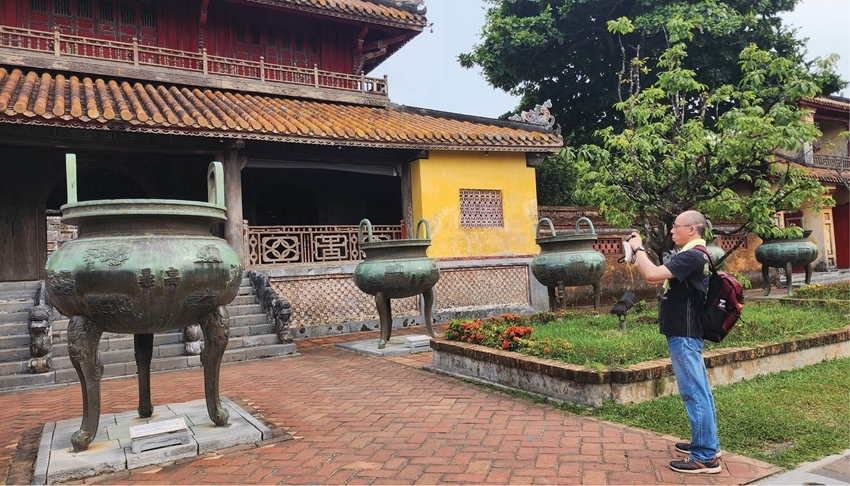 |
| Admiring the national treasure: The Nine Dynastic Urns |
Scientific preservation
The eight items/sets of items (comprising 33 individual artifacts) are considered national treasures and are exceptionally rare, embodying the nation's historical narrative. These include: The Nine Holy Cannons at Quang Duc gate and The Nhon Gate; the Nine Dynastic Urns at The Mieu courtyard (Imperial Citadel); the collection of bronze cauldrons, which includes two at the Can Chanh Palace, four at Khon Thai Palace, one at Kien Trung Palace, two at Long An Palace (Hue Museum of Royal Antiquities), and one at Ngung Hy Palace (Dong Khanh Tomb); the Nguyen Dynasty throne at the Thai Hoa Palace (currently exhibited at Hue Museum of Royal Antiquities while the palace is under restoration); the Giao Ritual Robe stored in the museum’s artifact collection; the Khiem Cung Ky Stele at Tu Duc Tomb; the Great Bell and the Stele "Ngu Kien Thien Mu Tu" at Thien Mu Pagoda.
Among the eight national treasures, only the Giao Ritual Robe is stored in the artifact archive, while the other 32 items are on display for visitors. According to Mr. Ngo Van Minh, Director of Hue Museum of Royal Antiquities, the conservation and promotion of the treasures are priorities for the cultural sector, the HMCC, and local authorities.
In line with the Heritage Law, national treasures require special preservation. “The Giao Ritual Robe is well-preserved, but since it is made of fabric and has aged hundreds of years, its preservation requires strict control of humidity, light, and air conditions to minimize environmental impacts. The artifact storage staff regularly check and address any issues such as moisture or mold. The robe is only displayed during significant and necessary events, and afterward, it is returned to storage. Preservation follows scientific methods with consultation from experts,” Mr. Minh explained.
Enhancing the value of national treasures
Visiting Hue with his family this summer, Smith, a tourist from the U.S., expressed that he really liked the Ancient Capital of Hue. “I have viewed and learned about the Nine Holy Cannons and was truly impressed. I hope that you will preserve and protect these treasures well, as doing so is also safeguarding the culture of Hue and Vietnam,” he said.
"According to Mr. Hoang Viet Trung, Director of HMCC, at display sites of the national treasures, the center has placed signage and attached QR codes for visitors to access further information. Additionally, all national treasures have been digitized in 3D, integrating technology into the management and display of the artifacts to further promote their value.
We regularly promote the treasures through various media, including publications in specialized journals, both domestic and international. We collaborate with media outlets to produce TV documentaries on the treasures, broadcast them internationally, and include information in the Heritage Education Program to help students understand the historical significance and value of these treasures, fostering a sense of responsibility for preserving and enhancing heritage,” Mr. Trung added.
In 2020, the HMCC published "National Treasures of the Nguyen Dynasty in Hue," and in June 2023, they launched the exhibition "The Landscape of Vietnam on the Nine Dynastic Urns" at Hien Lam Pavilion (Imperial Citadel). The exhibit remains ongoing, with modern digital displays making the national treasures more dynamic and engaging. These invaluable historical and cultural artifacts are being creatively showcased to reach a wider audience, particularly younger generations, helping them better understand and appreciate the heritage preserved for centuries.
National treasures represent historical periods and reflect the cultural life of the Vietnamese people in different eras. They are protected and specially preserved by the State of Vietnam.
